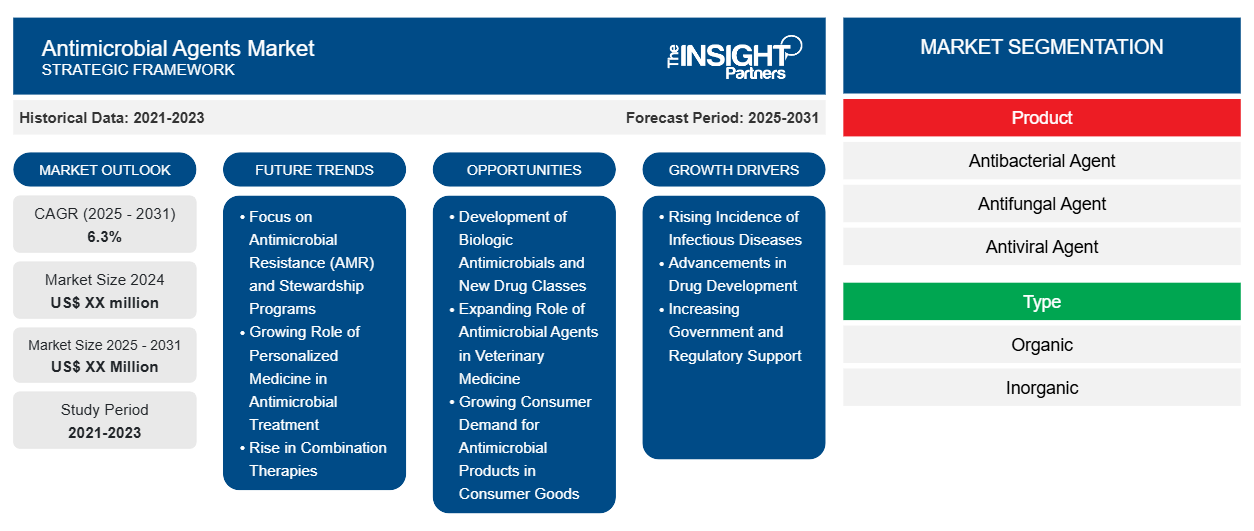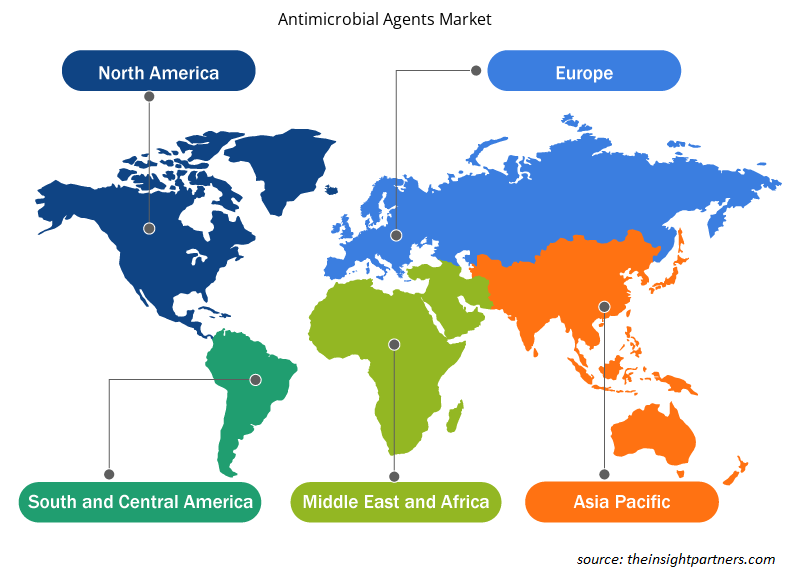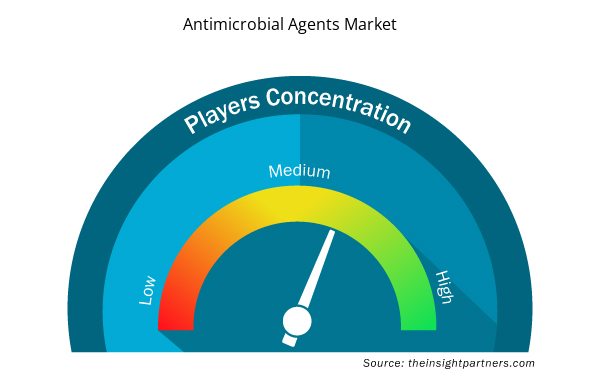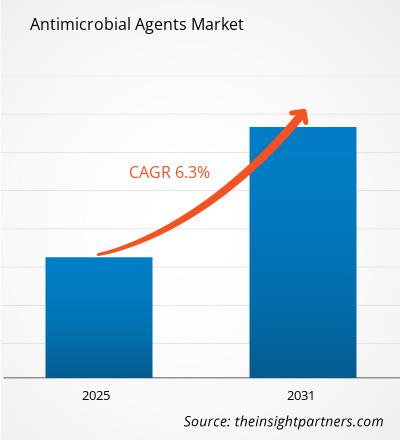The Antimicrobial Agents Market is expected to register a CAGR of 6.3% from 2025 to 2031, with a market size expanding from US$ XX million in 2024 to US$ XX Million by 2031.
The report is segmented by Product (Antibacterial Agent, Antifungal Agent, Antiviral Agent, Antiparasitic Agent); Type (Organic, Inorganic); Form (Dry, Liquid); Application (Plastics, Paint and Coatings, Pulp and Paper, Cosmetic Preparations); and End User (Healthcare, Packaging, Food and Beverages, Pharmaceutical, Others). The global analysis is broken down at the regional level and for major countries. The market evaluation is presented in US$ for the above segmental analysis.
Purpose of the Report
The report Antimicrobial Agents Market by The Insight Partners aims to describe the present landscape and future growth, top driving factors, challenges, and opportunities. This will provide insights to various business stakeholders, such as:
- Technology Providers/Manufacturers: To understand the evolving market dynamics and know the potential growth opportunities, enabling them to make informed strategic decisions.
- Investors: To conduct a comprehensive trend analysis regarding the market growth rate, market financial projections, and opportunities that exist across the value chain.
- Regulatory bodies: To regulate policies and police activities in the market with the aim of minimizing abuse, preserving investor trust and confidence, and upholding the integrity and stability of the market.
Antimicrobial Agents Market Segmentation
Product
- Antibacterial Agent
- Antifungal Agent
- Antiviral Agent
- Antiparasitic Agent
Type
- Organic
- Inorganic
Form
- Dry
- Liquid
Application
- Plastics
- Paint and Coatings
- Pulp and Paper
- Cosmetic Preparations
End User
- Healthcare
- Packaging
- Food and Beverages
- Pharmaceutical
Customize This Report To Suit Your Requirement
You will get customization on any report - free of charge - including parts of this report, or country-level analysis, Excel Data pack, as well as avail great offers and discounts for start-ups & universities
Antimicrobial Agents Market: Strategic Insights

- Get Top Key Market Trends of this report.This FREE sample will include data analysis, ranging from market trends to estimates and forecasts.
Antimicrobial Agents Market Growth Drivers
- Rising Incidence of Infectious Diseases: Emerging economies experience higher rates of infectious diseases which fuel market growth for antimicrobial agents. Population growth along with urbanization and aging populations cause infectious diseases like pneumonia urinary tract infections and sepsis to become more common. As chronic diseases like diabetes and cancer rise in prevalence they weaken immune systems which leads to increased susceptibility to infections thus driving antimicrobial agents demand higher. The diseases compromise the immune system which leaves the body exposed to bacterial, viral, and fungal infections. The global spread of infections heightens the urgency for effective antimicrobial agents to prevent and manage these diseases. The healthcare sector depends on antimicrobial agents like antibiotics and antivirals to fight infections which results in market expansion. The growing number of hospital-acquired infections (HAIs) creates more demand for antimicrobial treatments especially in medical facilities. The increase in understanding how important timely and effective infection treatment is leads to wider adoption of antimicrobial treatments. The worldwide increase of drug-resistant infections like multi-drug-resistant tuberculosis and MRSA boosts the need for new antimicrobial medications which can fight resistant pathogens. The pharmaceutical market for antimicrobial agents will expand because the global burden of infectious diseases keeps increasing and companies are investing in new antimicrobial drug development.
- Advancements in Drug Development: The ongoing growth of antimicrobial drug development drives market expansion. Scientists together with pharmaceutical firms are working towards creating stronger antimicrobial treatments to fight against the expanding challenge of antimicrobial resistance (AMR). Antimicrobial resistance (AMR) develops as microorganisms adapt to resist drugs that previously eliminated them which results in standard treatments becoming ineffective. Global rise in AMR requires immediate creation of novel antimicrobial treatments to combat resistant infections. Research efforts are focused on producing new antibiotic classes such as carbapenemase inhibitors and next-generation cephalosporins which aim to combat resistant bacterial strains. There has been an increase in targeted antimicrobial drug development which led to narrow-spectrum antibiotics that attack only harmful pathogens but protect helpful body microbes. New antiviral drugs are being created to fight recent viral outbreaks like COVID-19 while researchers improve antifungal treatments for diseases which have become more common. Nanotechnology research is being used to create antimicrobial agents with higher effectiveness and reduced side effects. Global health threats including drug-resistant pathogens and viral pandemics drive pharmaceutical companies to invest in research and development for new innovative antimicrobial agents. The advances present not just potential treatment solutions for drug-resistant infections but also significant market share capture opportunities which expand growth possibilities in the antimicrobial agents industry.
- Increasing Government and Regulatory Support: Worldwide government and regulatory bodies act as key supporters of the antimicrobial agents market expansion. The emergence of infectious diseases and antimicrobial resistance as global threats drives governments to make substantial investments in R&D for innovative antimicrobial agents. Numerous nations have started implementing active strategies to encourage antibiotic and antimicrobial drug development through incentives. The "GAIN Act" in the United States offers financial incentives to develop new antibiotics targeting serious infections from resistant pathogens. The World Health Organization together with other international bodies has set priorities against antimicrobial resistance and encourages governmental action for policies that drive innovation in this field. Governments are financing collaborations between public entities and private companies to speed up the development and market entry of new antimicrobial treatments. Research-to-market collaborations are fundamental to overcoming drug resistance because they enable the development of market-ready products that address worldwide antimicrobial resistance. Regulatory bodies such as the FDA and EMA are making the approval procedure for antimicrobial agents more efficient to expedite the availability of effective drugs on the market. Government and regulatory support remains essential for promoting innovation while supporting research and development to ensure that new antimicrobial agents undergo proper development and approval processes before reaching healthcare providers.
Antimicrobial Agents Market Future Trends
- Focus on Antimicrobial Resistance (AMR) and Stewardship Programs: Antimicrobial resistance remains one of modern medicine's greatest ongoing battles. As resistant pathogens become more common in the market for antimicrobial agents this situation drives researchers to concentrate on producing medications that target resistant infections. Microorganisms develop resistance to treatment drugs through evolutionary changes which results in antimicrobial resistance. Antibiotic overuse and misuse worsens this problem by making bacteria harder to treat. Antimicrobial stewardship programs have become a priority because they optimize antimicrobial usage to prevent resistance development. Hospitals, clinics and healthcare institutions worldwide are adopting these programs to minimize unnecessary antimicrobial prescriptions and guarantee proper drug usage. Antimicrobial stewardship programs work to improve infection prevention while advancing diagnostic methods so healthcare providers can prescribe appropriate drugs for specific pathogens. Growing worldwide worries about antimicrobial resistance should boost the need for new drugs that can successfully attack resistant infections. Antimicrobial resistance (AMR) drives pharmaceutical companies to fund research for new drugs and treatment strategies as this pattern will persistently influence the antimicrobial market's evolution.
- Growing Role of Personalized Medicine in Antimicrobial Treatment: The antimicrobial agents market is increasingly influenced by the rising trend of personalized medicine. This treatment strategy customizes antimicrobial therapy for each patient by considering their genetic composition along with their microbiome and particular pathogens. Personalized medicine works to improve treatment outcomes by matching patients with the ideal antimicrobial agents for their specific condition which lowers the risks of antimicrobial resistance and negative drug reactions. Personalized medicine relies heavily on pharmacogenomics which examines the relationship between genetic profiles and medication responses in individuals. Healthcare providers can tailor each patient's treatment plan effectively by learning about the genetic elements that determine how drugs work and cause side effects. Diagnostic tool innovations like rapid pathogen identification tests and resistance profiling enable clinicians to select the proper antimicrobial agents with enhanced precision. The approach of trial-and-error treatment traditionally used for infections becomes less common. Personalized medicine proves especially beneficial when treating chronic infections and hospital-acquired infections (HAIs) along with pathogens that resist standard antibiotics because these traditional treatments often do not work effectively. The medical community expects the application of personalized antimicrobial treatments to increase as genomic technologies and diagnostics develop further which will lead to improved patient results and decreased antimicrobial drug overuse. The movement toward precision medicine will probably increase demand for advanced diagnostic tools and specialized antimicrobial agents that target particular infections and patient profiles.
- Rise in Combination Therapies: The antimicrobial agents market is experiencing growth in combination therapy approaches. Medical researchers have started developing combination drug treatments that merge several antimicrobial agents because antimicrobial resistance is increasing. Researchers are developing stronger antimicrobial treatments through drug class combinations because these combinations enable simultaneous attacks on multiple pathogens or multiple mechanisms within the same microorganism. Multi-drug-resistant infections require combination therapies because they present a broad approach to fight against resistant bacteria, fungi, and viruses. Multiple therapeutic areas like antibiotics along with antivirals and antifungals are exhibiting this trend. In tuberculosis treatment multiple antibiotics have been the recognized standard approach for many decades. New combination treatment approaches are under development for HIV/AIDS patients and those with cancer-related infections as well as fungal diseases. Combination therapies improve effectiveness and lower the risk of resistance to single medications. The antimicrobial agents market is projected to expand due to rising demands for enhanced treatments along with efforts to fight resistant infections through combination therapies. The rising complexity of infections combined with multi-drug-resistant pathogens positions combination therapies as a primary focus for pharmaceutical companies who see this as an avenue for growth.
Antimicrobial Agents Market Opportunities
- Development of Biologic Antimicrobials and New Drug Classes: The creation of biologic antimicrobials together with new drug categories stands to boost the growth potential of the antimicrobial market. Scientists continue to investigate biologic drugs derived from living organisms for their distinctive infection-targeting capabilities. Monoclonal antibodies, antimicrobial peptides and vaccines as biologics deliver precise treatment options that produce fewer side effects than traditional antimicrobial drugs. The medical treatment sector predicts biologics will expand because they target infections that resist standard treatments. Creating new categories of antibiotics and antiviral treatments remains essential to fight antimicrobial resistance effectively. The market should anticipate the emergence of new drug classes thanks to pharmaceutical companies' research and development investments which will provide efficient treatments for resistant infections. The rise of biologics and novel drugs could provide a competitive edge for companies in the antimicrobial agents market, opening up new avenues for growth and innovation.
- Expanding Role of Antimicrobial Agents in Veterinary Medicine: Biologics along with innovative drugs will provide competitive advantages for companies in the antimicrobial agents market while creating new growth opportunities and driving innovation. As the global demand for animal protein expands the requirement for effective antimicrobial agents in animal husbandry and agriculture grows. The treatment and prevention of infections in livestock and poultry as well as companion animals depend on antimicrobial agents. These agents protect animal health while stopping disease outbreaks and safeguarding food products from animals. Veterinary medicine sees more antimicrobial agents adopted because of increased recognition of animal health needs and their effectiveness in managing zoonotic diseases which have human transmission potential. The rising incidence of bacterial infections in livestock together with the worldwide growth of animal farming operations increases the requirement for better antimicrobial solutions. Concerns about AMR development have emerged because of excessive antimicrobial agent use in animals. Research and development efforts are now concentrating on veterinary antimicrobial agents designed to be effective while reducing the risk of resistance spreading to humans. The development of precise antimicrobial treatments alongside vaccines minimizes antibiotic requirements. As veterinary medicine incorporates more antimicrobial agents emerging economies experience growth in agricultural sectors which represents a major opportunity for companies operating in animal health. Market growth will accelerate in the next few years because there is a growing demand for safe animal antimicrobial products.
- Growing Consumer Demand for Antimicrobial Products in Consumer Goods: Non-pharmaceutical sectors are witnessing increased consumer demand for antimicrobial products which creates a distinctive growth chance for antimicrobial agents. Public consciousness about infectious diseases especially after COVID-19 has resulted in heightened consumer interest for antimicrobial features in daily products. Antimicrobial soaps and personal care items along with cleaning agents and sanitizers are becoming more popular because people now focus on hygiene and disease prevention during their daily routines. Consumer demand for antimicrobial-treated textiles such as clothing, bedding, and footwear increases because buyers desire materials that minimize bacterial and fungal infection risks. A range of products including medical devices along with wound care products and packaging materials now contain antimicrobial agents. Integration of antimicrobial agents into consumer products drives market expansion beyond traditional healthcare and pharmaceutical sectors. Consumer goods manufacturers integrate antimicrobial technologies into their products because consumers demand higher hygiene standards and protection against pathogens. The food industry faces growth in contamination and spoilage concerns which packaging materials now address using antimicrobial agents. Experts predict substantial market growth for consumer products with antimicrobial agents due to rising global hygiene concerns and infection control needs which influence consumer buying choices. Businesses that develop antimicrobial solutions for multiple consumer goods sectors can take advantage of these expanding market opportunities.
Antimicrobial Agents Market Regional Insights
The regional trends and factors influencing the Antimicrobial Agents Market throughout the forecast period have been thoroughly explained by the analysts at Insight Partners. This section also discusses Antimicrobial Agents Market segments and geography across North America, Europe, Asia Pacific, Middle East and Africa, and South and Central America.

- Get the Regional Specific Data for Antimicrobial Agents Market
Antimicrobial Agents Market Report Scope
| Report Attribute | Details |
|---|---|
| Market size in 2024 | US$ XX million |
| Market Size by 2031 | US$ XX Million |
| Global CAGR (2025 - 2031) | 6.3% |
| Historical Data | 2021-2023 |
| Forecast period | 2025-2031 |
| Segments Covered |
By Product
|
| Regions and Countries Covered | North America
|
| Market leaders and key company profiles |
Antimicrobial Agents Market Players Density: Understanding Its Impact on Business Dynamics
The Antimicrobial Agents Market market is growing rapidly, driven by increasing end-user demand due to factors such as evolving consumer preferences, technological advancements, and greater awareness of the product's benefits. As demand rises, businesses are expanding their offerings, innovating to meet consumer needs, and capitalizing on emerging trends, which further fuels market growth.
Market players density refers to the distribution of firms or companies operating within a particular market or industry. It indicates how many competitors (market players) are present in a given market space relative to its size or total market value.
Major Companies operating in the Antimicrobial Agents Market are:
- Nanobiomatters,
- BASF SE,
- RTP Company,
- Microban International,
- Clariant,
Disclaimer: The companies listed above are not ranked in any particular order.

- Get the Antimicrobial Agents Market top key players overview
Key Selling Points
- Comprehensive Coverage: The report comprehensively covers the analysis of products, services, types, and end users of the Antimicrobial Agents Market, providing a holistic landscape.
- Expert Analysis: The report is compiled based on the in-depth understanding of industry experts and analysts.
- Up-to-date Information: The report assures business relevance due to its coverage of recent information and data trends.
- Customization Options: This report can be customized to cater to specific client requirements and suit the business strategies aptly.
The research report on the Antimicrobial Agents Market can, therefore, help spearhead the trail of decoding and understanding the industry scenario and growth prospects. Although there can be a few valid concerns, the overall benefits of this report tend to outweigh the disadvantages.
- Historical Analysis (2 Years), Base Year, Forecast (7 Years) with CAGR
- PEST and SWOT Analysis
- Market Size Value / Volume - Global, Regional, Country
- Industry and Competitive Landscape
- Excel Dataset


- High Speed Cable Market
- Biopharmaceutical Tubing Market
- Photo Printing Market
- Vision Guided Robotics Software Market
- Ceramic Injection Molding Market
- Lyophilization Services for Biopharmaceuticals Market
- Lymphedema Treatment Market
- Cut Flowers Market
- Underwater Connector Market
- Constipation Treatment Market

Report Coverage
Revenue forecast, Company Analysis, Industry landscape, Growth factors, and Trends

Segment Covered
This text is related
to segments covered.

Regional Scope
North America, Europe, Asia Pacific, Middle East & Africa, South & Central America

Country Scope
This text is related
to country scope.
Frequently Asked Questions
The Antimicrobial Agents Market is estimated to witness a CAGR of 6.3% from 2025 to 2031.
The major factors driving the Antimicrobial Agents Market are Rising Incidence of Infectious Diseases, Advancements in Drug Development, and Increasing Government and Regulatory Support.
Future trends in the Antimicrobial Agents Market are Focus on Antimicrobial Resistance (AMR) and Stewardship Programs, Growing Role of Personalized Medicine in Antimicrobial Treatment, and Rise in Combination Therapies.
Some of the players operating in the market are Nanobiomatters, BASF SE, RTP Company, Microban International, Clariant, Momentive, Life Material Technologies Limited, RADICAL MATERIALS LTD, SANITIZED AG, Akzo Nobel N.V.
The report can be delivered in PDF/PPT format; we can also share an excel datasheet based on the request.
Some customization options available based on the request are an additional 3–5 company profiles and a country-specific analysis of 3–5 countries of your choice. Customizations are to be requested/discussed before making final order confirmation# as our team would review the same and check the feasibility.
Trends and growth analysis reports related to Life Sciences : READ MORE..
1. Nanobiomatters
2. BASF SE
3. RTP Company
4. Microban International
5. Clariant
6. Momentive
7. Life Material Technologies Limited
8. RADICAL MATERIALS LTD
9. SANITIZED AG
10. Akzo Nobel N.V.

 Get Free Sample For
Get Free Sample For